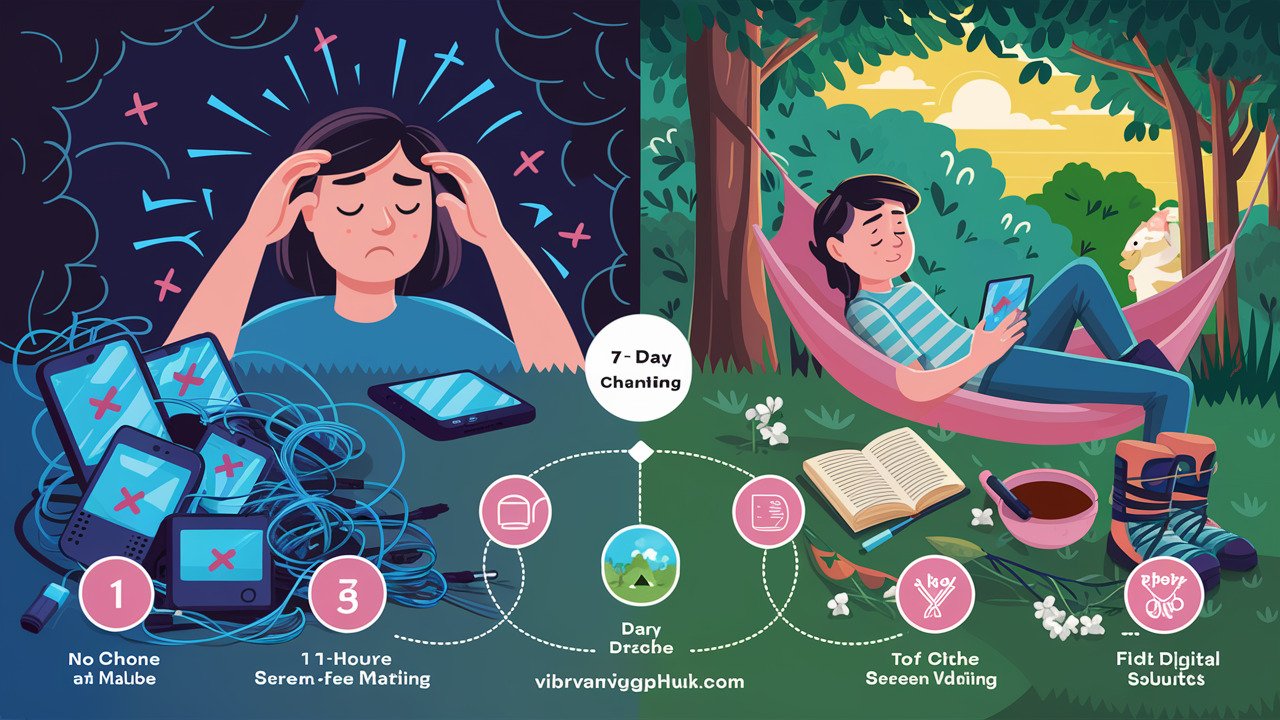Digital Detox Challenge: 7 Days to Reduce Screen Time & Stress
Are you tired of feeling overwhelmed by the constant barrage of digital notifications and the pressure to be perpetually connected? You’re not alone. In today’s hyperconnected world, it’s easy to get caught up in the endless stream of information, leading to increased stress and anxiety.
By taking a structured approach to reducing your screen time, you can regain control over your relationship with technology and improve your overall well-being. This 7-day challenge is designed to help you do just that, with practical strategies and reflection activities to guide you toward a healthier digital balance.
Key Takeaways
- Learn how to reduce your screen time and alleviate stress
- Discover practical strategies for a healthier digital balance
- Understand the benefits of temporary digital disconnection
- Develop sustainable habits to maintain your digital wellness
- Improve your overall quality of life by being more present
The Digital Overload Problem
In today’s digital age, the constant bombardment of information can be overwhelming. Our increasing dependence on digital devices has created a state of constant connectivity that significantly impacts our mental health and well-being.
How Technology Affects Our Mental Health
The excessive use of digital devices can lead to heightened stress, impaired sleep, and reduced attention span. According to a survey by the American Psychological Association, 86% of Americans report constantly checking their emails and social media, leading to stress. Constant exposure to social media can trigger comparison anxiety, FOMO (fear of missing out), and feelings of inadequacy.
| Effects of Digital Overload | Symptoms |
|---|---|
| Mental Health | Stress, anxiety, feelings of inadequacy |
| Physical Health | Eye strain, headaches, disrupted sleep patterns |
| Productivity | Reduced attention span, distraction |
Signs You Need a Digital Detox
Key signs that you might need a digital detox include feeling anxious when separated from your phone, checking devices first thing in the morning and last thing at night, and difficulty focusing on tasks without digital distractions. If you find yourself mindlessly scrolling, losing track of time online, or experiencing relationship issues due to device use, these are clear indicators that your digital habits need reassessment.
Benefits of a Digital Detox Challenge
Embarking on a digital detox challenge can be a transformative experience, offering numerous benefits for both mental and physical well-being. By disconnecting from the digital world, you can rejuvenate your mind, improve your mental health, and develop healthier habits.
Improved Mental Clarity and Focus
Undertaking a detox challenge can significantly improve your mental clarity and focus by removing the constant distractions that fragment your attention throughout the day. With fewer digital interruptions, you’ll be able to concentrate better and achieve more in less time.
Better Sleep Quality
Reducing screen time, especially before bed, can lead to better sleep quality. Digital devices emit blue light, which can disrupt the production of melatonin, a hormone that regulates sleep. By avoiding screens before bedtime, you can improve your sleep hygiene and wake up feeling more refreshed.

Reduced Stress and Anxiety
Many participants in digital detox programs report reduced stress and anxiety levels as they disconnect from the constant stream of news, work emails, and social media comparisons. This break from digital noise can help you feel more calm and centered.
Enhanced Personal Relationships
Your personal relationships can flourish during a digital detox challenge as you become more present and engaged in face-to-face interactions without the interruption of notifications or the urge to check your phone. This increased mindfulness can lead to deeper, more meaningful connections with others. For more insights on digital detox, you can explore resources like Cirkledin’s Digital Detox Guide.
Preparing for Your 7-Day Digital Detox Challenge
As you prepare to embark on your 7-day digital detox challenge, it’s essential to lay the groundwork for a successful experience. This involves several key steps that will help you stay on track and maximize the benefits of your digital detox.
Setting Clear Goals and Intentions
Before diving into your 7-day digital detox challenge, it’s crucial to set clear, achievable goals about what you hope to accomplish. Whether it’s reducing overall screen time, improving sleep, or being more present with family, having specific objectives in mind will guide your actions throughout the challenge.
Informing Friends and Colleagues
Let your friends and co-workers know you plan to take a digital break, so they don’t expect an instant reply to an email, text, or FaceTime calls. Consider enlisting a few friends, co-workers, or family members to join you in your digital detox challenge—having accountability partners can make the experience more enjoyable and increase your chances of success.
Creating a Supportive Environment
Prepare your environment by removing temptations: delete social media apps temporarily, turn off non-essential notifications, and create physical spaces in your home that are device-free zones. Plan alternative activities in advance to fill the time you’d normally spend on devices, such as having books ready, planning outdoor activities, or scheduling face-to-face social engagements.

Digital Detox Challenge: 7 Days to Reduce Screen Time & Stress
In today’s digital age, taking a step back to reassess our screen time is crucial, and a 7-day digital detox challenge can be the perfect starting point. This challenge is designed to help you become more mindful of your digital habits and reduce the stress associated with constant connectivity.
Day 1: Awareness and Observation
On the first day of your digital detox challenge, the focus is on awareness and observation. Today, you’ll simply notice your digital habits without judgment, tracking when and why you reach for your devices and how it makes you feel. The goal is to accumulate 2 hours of cumulative device-free time. Start by observing your screen time during daily activities and identify patterns or triggers that lead to excessive device usage.
Day 2: Setting Boundaries During Meals
On Day 2, you’ll establish boundaries during meals by keeping all devices away from the table. This allows you to fully engage with your food and any dining companions, increasing your device-free time to 3 hours. By doing so, you’ll enhance your dining experience and foster better connections with others.
Day 3: Mindful Mornings Without Devices
Day 3 challenges you to create mindful mornings by avoiding all digital devices for the first hour after waking. Instead of checking emails or scrolling through social media, engage in activities like meditation, journaling, or exercise. This practice extends your device-free time to 4 hours and sets a positive tone for the day.

Day 4: Digital Decluttering and Minimalism
For Day 4, you’ll focus on digital decluttering by unsubscribing from unnecessary emails, deleting unused apps, and turning off non-essential notifications. This creates a more intentional digital environment while aiming for 5 hours away from screens. By decluttering your digital space, you’ll reduce digital noise and improve your focus.
Day 5: Reconnecting Offline
Day 5 is about reconnecting offline through face-to-face interactions, outdoor activities, or pursuing hobbies that don’t involve screens. This pushes your device-free time to 6 hours and strengthens your real-world connections. Engage in activities that bring you joy and help you build meaningful relationships.
Day 6: Device-Free Evenings for Better Sleep
On Day 6, you’ll create device-free evenings by putting away all screens at least 2 hours before bedtime. This allows your brain to wind down naturally and improves your sleep quality, with a goal of 7 hours total without devices. Establishing a pre-bedtime routine can significantly enhance your rest and overall well-being.
Day 7: Full Day Digital Detox Challenge
The challenge culminates on Day 7 with a full day digital detox. You’ll completely disconnect from all digital devices for the entire day, immersing yourself in offline activities and experiencing the full benefits of being present without digital distractions. This final day is a celebration of your newfound ability to stay connected without devices.
Throughout the 7-day digital detox challenge, you’ll gradually increase your time away from screens, building confidence in your ability to disconnect and creating new habits that can continue beyond the challenge. By the end of the week, you’ll have experienced a progressive reduction in screen time and will likely notice significant improvements in your stress levels, focus, sleep quality, and overall well-being.
Overcoming Common Challenges
The digital detox challenge is not just about abstaining from digital devices; it’s also about overcoming the common hurdles that come with it. As you progress through your 7-day digital detox challenge, you’ll likely face several obstacles that can test your resolve.
Dealing with FOMO
One of the most significant challenges is dealing with FOMO (Fear of Missing Out), the anxiety that you’re missing important updates or events. To overcome FOMO, remind yourself that crucial information will reach you through other channels, and most social media content will still be available when your detox ends. Try reframing your experience as JOMO (Joy of Missing Out) instead. For more insights on managing FOMO, you can explore resources like Daily Mom’s 7-Day Digital Detox Challenge.
Managing Work Expectations
Managing work expectations is another hurdle, especially in jobs requiring constant connectivity. Communicate your digital detox plans clearly with your colleagues and supervisors in advance. Setting up auto-responses, delegating tasks, and establishing specific times to check work communications can help manage expectations.
Handling Digital Withdrawal Symptoms
Many people experience digital withdrawal symptoms, such as restlessness or anxiety, when separated from their devices. Recognize these symptoms as normal and temporary, and use mindfulness techniques to observe them without judgment.
| Challenge | Strategy |
|---|---|
| FOMO | Reframe as JOMO, focus on other channels for important info |
| Work Expectations | Communicate plans, set auto-responses, delegate tasks |
| Digital Withdrawal Symptoms | Use mindfulness, recognize symptoms as temporary |
By understanding these challenges and implementing effective strategies, you can successfully navigate your digital detox challenge and develop healthier digital habits.
Alternative Activities to Replace Screen Time
One of the keys to a successful digital detox is identifying activities that can fill the time you normally spend on your devices. By doing so, you’ll not only reduce your screen time but also enrich your life with more fulfilling experiences.
Outdoor and Physical Activities
Engaging in outdoor and physical activities is an excellent way to replace screen time. Try taking a daily walk in nature, cycling, swimming, or joining a local sports team. Research shows that spending time in natural environments can significantly reduce stress hormones and improve mood, making outdoor activities particularly beneficial during a digital detox.
Creative and Mindful Practices
Creative pursuits and mindful practices offer engaging alternatives to screen use. Consider drawing, painting, writing, playing a musical instrument, or practicing mindfulness through meditation or yoga. These activities not only occupy your time but also enhance your mental well-being by teaching you to be present in the present moment.
Social Connection Activities
Strengthening social connections face-to-face is one of the most rewarding ways to spend your newfound time. Organize game nights, coffee dates, dinner parties, or join clubs and community groups aligned with your interests. This shift from digital interaction to offline activities fosters deeper connections and a sense of community.
| Activity Type | Examples | Benefits |
|---|---|---|
| Outdoor and Physical | Walking, Cycling, Swimming, Sports | Reduces stress, Improves mood, Enhances physical health |
| Creative and Mindful | Drawing, Painting, Writing, Meditation, Yoga | Enhances mental well-being, Fosters creativity, Promotes mindfulness |
| Social Connection | Game nights, Coffee dates, Dinner parties, Community groups | Deepens connections, Fosters community, Enhances social skills |

By incorporating these alternative activities into your daily routine, you’ll be able to manage your time more effectively and enjoy a more balanced life.
Maintaining Digital Balance After the Challenge
The end of the digital detox challenge is just the beginning of a more mindful relationship with technology. As you reflect on your experience, consider how to integrate the lessons learned into your daily life.
Creating Sustainable Digital Habits
To maintain digital balance, focus on creating sustainable digital habits. This involves setting boundaries such as device-free meals, no phones in the bedroom, or designated check-in times for email and social media. Implementing a “time-blocking” approach can also be beneficial, where you schedule specific periods for checking digital devices.
| Digital Habit | Benefit | Implementation Tip |
|---|---|---|
| Device-free meals | Improved mindfulness and presence | Designate a device-free zone in your home |
| Time-blocking | Reduced digital distractions | Schedule specific times to check emails and social media |
| Digital minimalism | Less digital clutter and stress | Regularly review and remove unnecessary apps and digital tools |
Regular Mini-Detoxes
In addition to creating sustainable habits, consider incorporating regular mini-detoxes into your routine. This could involve device-free weekends or evenings, helping you maintain digital balance without the commitment of a full week-long detox. Utilize technology to manage your digital consumption by using apps that track screen time or block distracting websites.
Conclusion
The 7-Day Digital Detox Challenge is more than a digital reset; it’s a journey to a more balanced, mindful you. By completing this challenge, you’ve taken significant steps towards reducing screen time and stress, and improving your overall health and life.
You’ve experienced firsthand how a digital detox can decrease anxiety and create space for more meaningful activities and connections. This 7-day digital journey isn’t about rejecting technology but about establishing a more intentional relationship with it, achieving a better balance in life.
As you move forward, remember that digital detox is an ongoing practice. The strategies you’ve gained provide a foundation for long-term mindfulness and digital balance, enhancing your life. Consider sharing your experience to inspire others to examine their digital habits.
FAQ
What is the goal of the Digital Detox Challenge?
How do I prepare for the challenge?
What are some alternative activities to replace screen time?
How can I manage work expectations during the challenge?
What are the benefits of a digital detox?
How can I maintain digital balance after the challenge?
What if I experience digital withdrawal symptoms?
editor's pick
latest video
news via inbox
Nulla turp dis cursus. Integer liberos euismod pretium faucibua




